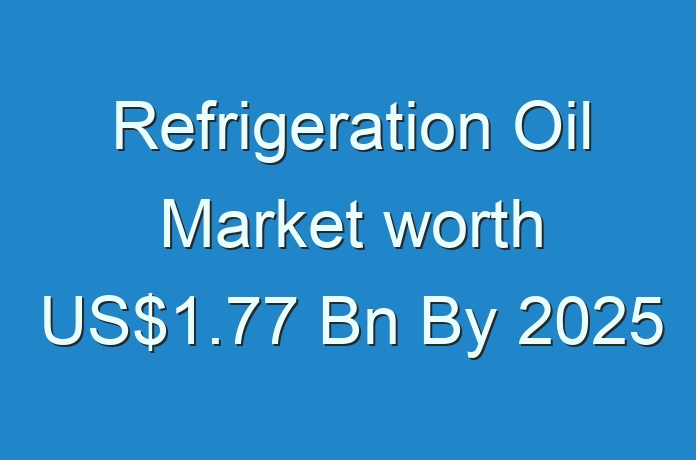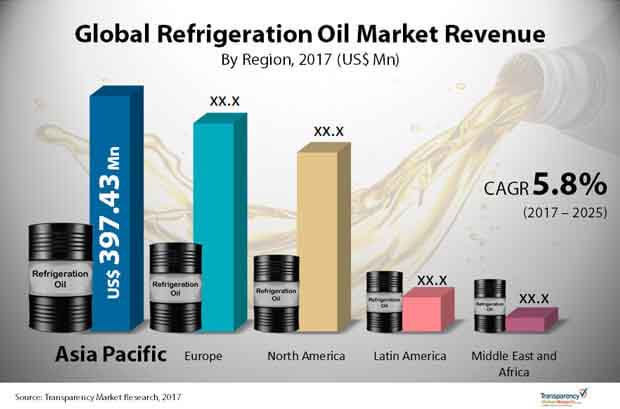
The global refrigeration oil market is anticipated to demonstrate healthy growth in coming years, as reported by Transparency Market Research (TMR). The competitive landscape of the global refrigeration oil market features consolidation at present. The top 5 players held 95% of the overall market share in the global market. These players are Exxon Mobil Corp., Royal Dutch Shell, Idemitsu Kosan Co., Ltd., MEIWA, and BASF. These vendors exert dominance in the global refrigerated oil market on account of their vast geographical reach and robust product portfolio.
Vendors in the global refrigeration oil market are expected to dedicate resources to research and development activities. This is a key strategy adopted by vendors in order to gain momentum by launching effective and innovative products in the refrigeration oil market. A prime example is the introduction of a hydrofluorocarbon-based refrigeration oil by Idemitsu Kosan Co., Ltd.
TMR projects the global refrigeration oil market to reach US$1.77 billion by 2025-end. The market is anticipated to grow at 5.8% CAGR over the forecast period 2017 to 2025.
More Trending Reports by Transparency Market Research –
Synthetic oil is expected to exhibit highest potential for growth among the product segments in the refrigeration oil market. High demand of the product due to its compatibility plays a key role in boosting this market segment. Among the regional segments, while North America will continue to be a dominant market, Asia Pacific is prognosticated to exhibit swift growth in the global refrigeration oil market in the coming years.

Rising Need for Food and Beverage Preservation to Boost Refrigeration Oil Market
The growing demand for coolers, freezers, air conditioners and car hVac system is propelling the growing intake of packaged food and the preservation and use of vaccines and medicinal products. The industry is being fuelled by increasing demands from the food and drug industries for refrigeration oil to increase its shelf life. Furthermore, increased demand for consumer equipment and increasing preference for GWP coolants are key factors which should drive the refrigeration oil market. Furthermore, technological progress and changing lifestyles of people globally influence the growth of the refrigeration oil market significantly.
Request PDF Brochure –
https://www.transparencymarketresearch.com/sample/sample.php?flag=B&rep_id=24065
Use of Nanoparticles to Emerge as Key Market Trend
Lubricant and additive chemicals that improve heat transfer and compressor efficiency have been given more attention over the last few years. Many companies worldwide incorporate nanoparticles in refrigerant oil to improve the properties of heat transfer. Current trends also include the use of coolants with a powerful affinity to metal, which have an activated polar molecule. These additives form a thin layer of the compressor’s metal surfaces. This layer lubricates the moving components of the compressor, thus improving the heat transfer and increasing system efficiency.
REQUEST FOR COVID19 IMPACT ANALYSIS –
https://www.transparencymarketresearch.com/sample/sample.php?flag=covid19&rep_id=24065
Emission of Fluorocarbons to Restrain Growth
The main restrictions on the growth of the refrigeration oil market are strict regulations limiting the use of fluorocarbon refrigerants. Government agencies have created stringent regulations to restrict the use of fluorocarbon coolants because of an increase in Green House gas emissions, with oil control complexities likely to limit the world refrigeration oil market. The shift to frozen and cooled products such as poultry, meat and milk, however, is forecast to escalate compressor demand, thus driving the refrigeration oil market during the forecast period.
This review is based on TMR’s report titled, “Refrigeration Oil Market (Product – Mineral Oil and Synthetic Oil; Refrigerant Type – Hydro Chlorofluorocarbon (HCFC), Chlorofluorocarbon (CFC), Hydro Fluorocarbon (HFC), and Ammonia; Application – Air conditioners , Coolers, Chillers, Refrigerators, and Condensers; End-use – Residential, Commercial, and Industrial) – Global Industry Analysis, Size, Share, Growth, Trends, and Forecast 2017 – 2025.”





